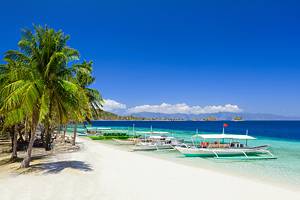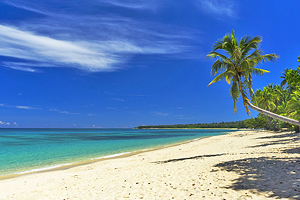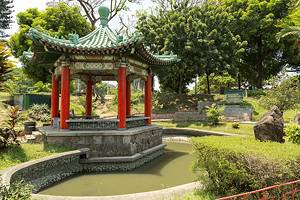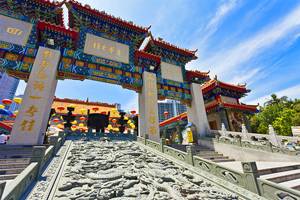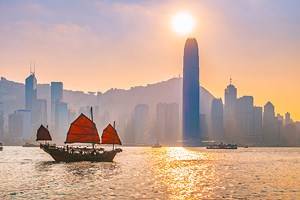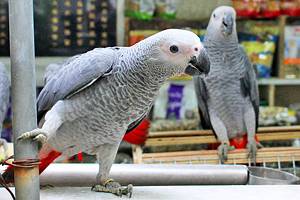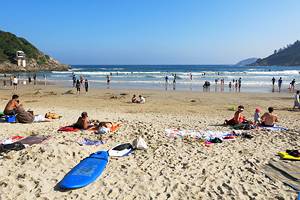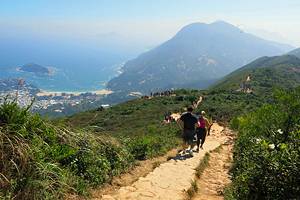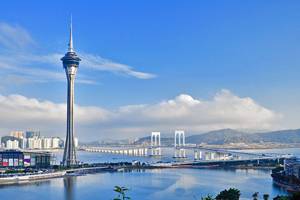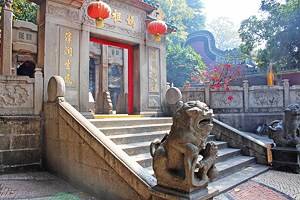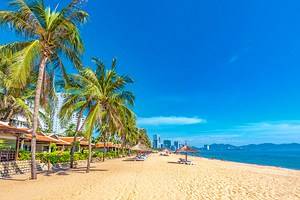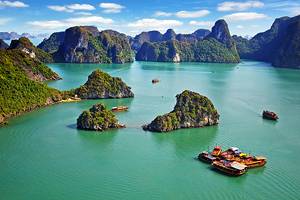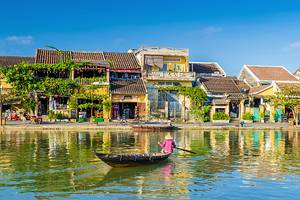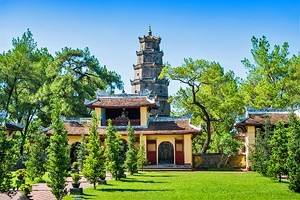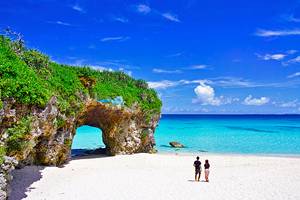Tourist Attractions & Things to Do in the Philippines
The Philippines is a tropical paradise in the Pacific Ocean made up of more than 7,000 islands that offer a natural playground for your inner explorer. Collectively, its landscapes feature an array of natural wonders, from volcanoes and rice terraces to underwater rivers and limestone caves, along with beautiful beaches.

Individually, the islands each offer something unique, whether you are looking for the best place to dive and snorkel or prefer to take in the historical sights in cities like Manila or Vigan.
Since the country is so spread out, a trip to the Philippines requires careful planning and some internal flights. Some destinations, like the Chocolate Hills in Bohol or the Hanging Coffins in Sagada, are remote, but getting there is well worth the effort. It's also important to consider the best time of year to visit the Philippines. The rainy season runs from June to November.
Plan your travels with our list of the top tourist attractions and things to do in the Philippines.
- White Beach, Boracay
- Relax on the Stunning Beaches of Palawan
- Chocolate Hills, Bohol
- Underground River Tour, Puerto Princesa
- Hanging Coffins, Sagada
- Diving in Coron
- Batad Rice Terraces, Banaue
- Mayon Volcano, Albay
- Island Hopping
- Manila Historical Sightseeing Tour
- Ride in a Jeepney
- Historic Tour of Corregidor Island
- Bird-Watching
- Pagsanjan Falls, Laguna
- Tour Colonial Vigan
- Taal Volcano, Talisay
- Jungle Training, Subic Bay
- Hanging Bridge, Sevilla
- Sugba Lagoon, Siargao
- Best Time to Visit The Philippines
White Beach, Boracay
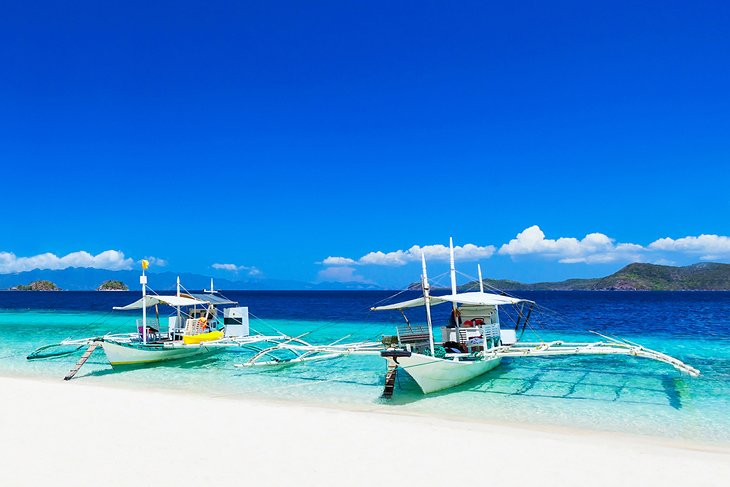
There is no shortage of pristine beaches in the Philippines, but if you are looking for a more active beach scene, one of the best places to visit is White Beach in Boracay. This is the most populous beach on the island but where you will find ample opportunities for boating and other water sports. It's also one of the most beautiful beaches in Asia.
Plenty of chairs and hammocks are beneath the palm trees, so you can relax and enjoy the pure white sand. You can even book a beachside massage. Snorkeling is a popular activity at White Beach, but if you do not want to put in so much work, take a banana boat ride or book a trip on a glass-bottom boat.
Relax on the Stunning Beaches of Palawan

At the northern tip of the Island of Palawan are some of the most scenic beaches in the Philippines, unlike anything else you will find in the country. This is not just stunning soft sand and warm calm waters like you find in other areas of the Philippines. Add to this, limestone cliffs jutting up from the ocean, secrete coves that you can paddle into, and beautiful offshore islands. Some of the islands are also home to boutique luxury resorts.
The main town here is El Nido. A variety of boat trips offer day tours from El Nido to secluded beaches, sandbars, and bays. This is the most popular activity here and something that almost everyone signs up for when visiting. But you do not need to even leave El Nido, you can find this beautiful setting from the beaches around town.
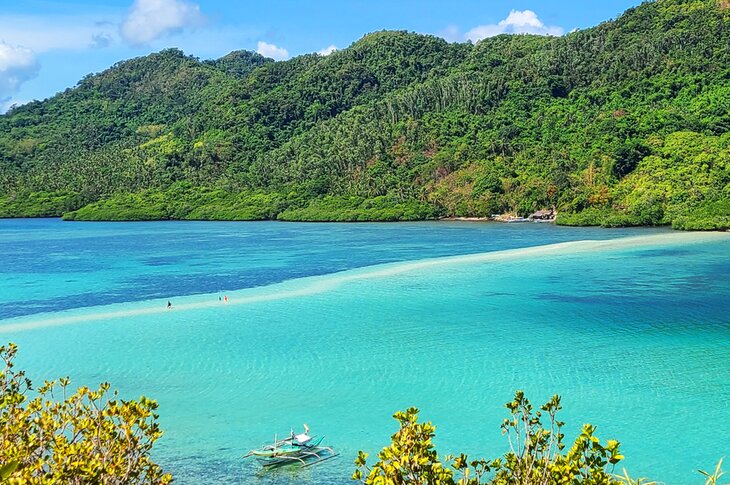
Northern Palawan is not overly developed. It has enough infrastructure to make things comfortable but it's not known for large resorts. If you are looking for luxury, it will be at small resorts and lodges. If you are looking for budget accommodation, you can find this as well in town but off the beach.
Palawan appeals to everyone from adventurous families to backpackers. A small airport in El Nido offers direct flights to Manila. The city of Puerto Princesa is also found on the island of Palawan, about a 5-hour drive from El Nido. If you want to see the Underground River in Puerto Princesa, you may want to fly into El Nido and out of Puerto Princesa or vice versa.
Chocolate Hills, Bohol
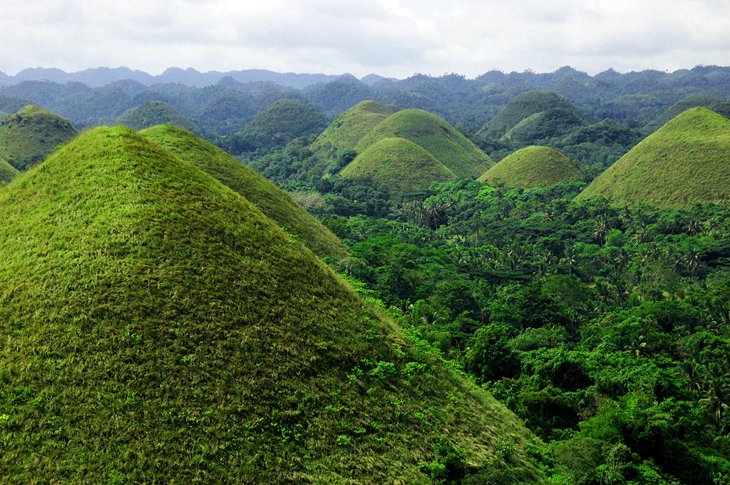
The geological wonder on the island of Bohol known as the Chocolate Hills is a unique natural phenomenon. This UNESCO World Heritage site is a protected area that features more than 1,200 small mountains that emerged above the ground over several centuries.
The area was once under the ocean, and these unique hills expand in every direction. They are green during much of the year, but during the dry season, they turn to a chocolate-brown color, thus the name, chocolate hills.
A convenient path leads to the top of a lookout area, which provides the best view. Be sure to observe the many delicate flowers along the walkway that are unique to this area.
Underground River Tour, Puerto Princesa

Taking a river tour of the Underground River near Puerto Princesa is one of the most awe-inspiring things to do in the Philippines. The underground river on Palawan Island is inside the Subterranean River National Park, a UNESCO World Heritage site.
The boat tours take you to experience the majestic five-mile river that runs below ground. The trip takes you through an intricate cave system surrounded by vertical limestone cliffs. You can see ancient stalagmite and stalactite formations, as well as bats flying overhead, as the coolness of the cave balances the tropical heat outside.
As you float through the dark caves on emerald water, your guide will identify points of interest and tropical wildlife that live along the river, which flows into the South China Sea.

You can take a tour from Puerto Princesa, which is a long day due to the drive time involved. A better alternative is to stay in Sabang (which is about an hour and a half from Puerto Princesa) and hop on a tour boat right from there. This way you can see the cave in a morning or an afternoon. Sabang also has a beautiful beach and decent accommodation and is a nice place to spend a day or two whether or not you are visiting the cave.
Hanging Coffins, Sagada

The hanging coffins in Sagada, located in the northern Cordillera Mountains, is one of the most unusual sights in the Philippines. The hanging coffins, some centuries old, are suspended from the cliffs of the Echo Valley. These ceremonial burials were reserved for the wealthy tribesmen.
Getting to the mountainous region requires some travel time. Although transportation to this area is now easier than it used to be, it still requires some physical endurance to hike the steep and narrow paths to the secluded coffins.
You will want sturdy shoes, and you may want to train before your trip to adapt more quickly to the high altitude. The reward is a sight you will never forget and well-earned bragging rights.
Diving in Coron

Coron Island in the Philippines, as well as other nearby islands, are popular diving locations in the country due to the abundance of coral reefs and shipwrecks.
The sunken ships to explore on Sangat Island in Coron are some of the best diving sites in the world. The wrecks are at varied depths that are suitable for both deep-water scuba divers and shallow-water snorkeling.
The shipwrecks, many from WWII, have become habitats for diverse fish species. The clear water makes for easy viewing of the shipwrecks and underwater wildlife. Many of the shipwrecks are from an attack on the Imperial Japanese Navy in 1944. Deep divers will want to view the Akitsushima Maru warship, Irako Maru, and the Kyokuzan Maru.
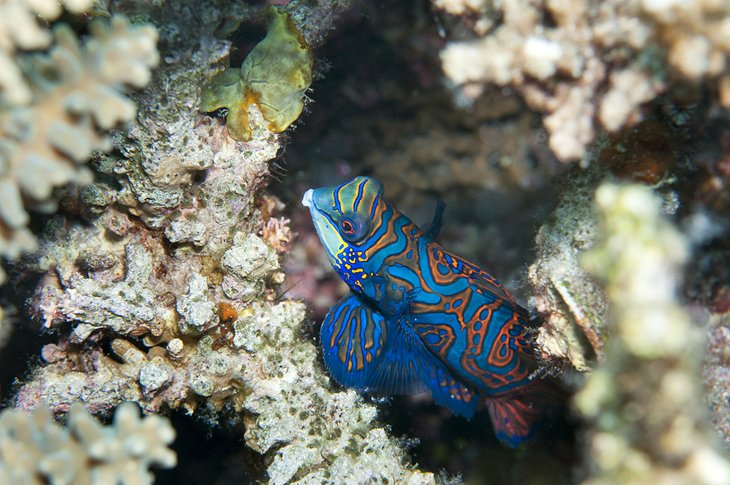
The Coral Garden is a specific site with particularly accessible coral and fish species. Snorkeling and diving tours to the Coral Garden often encompass stops at nearby shipwrecks.
If you are unsure where to snorkel to see some of the best coral, taking an organized trip to the Coral Garden is an easy introduction to the sport. Guides are able to point out sea turtles and fish and offer information about what kinds of coral you are viewing underwater.
Batad Rice Terraces, Banaue
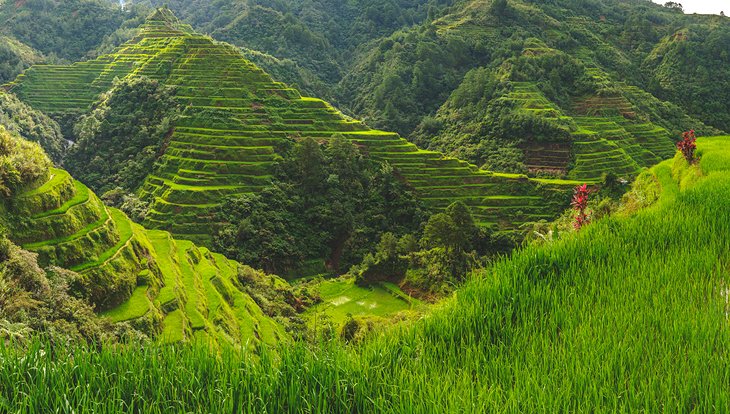
Viewing the Batad rice terraces at sunrise in Banaue is an unforgettable experience. This is especially recommended for landscape photographers who want to capture compelling images of Philippine agriculture. Some of these terraces are more than 2,000 years old and represent a common form of farming in the country.
The stacked terraces are carved by hand into the mountainside, creating vertical farming fields in a region void of flat land. Workers commonly plant rice and vegetables. You can walk some roads above the terraces that give you the best view by looking below. Early morning and dusk provide the best light to illuminate the electric green color of the fields.
Mayon Volcano, Albay
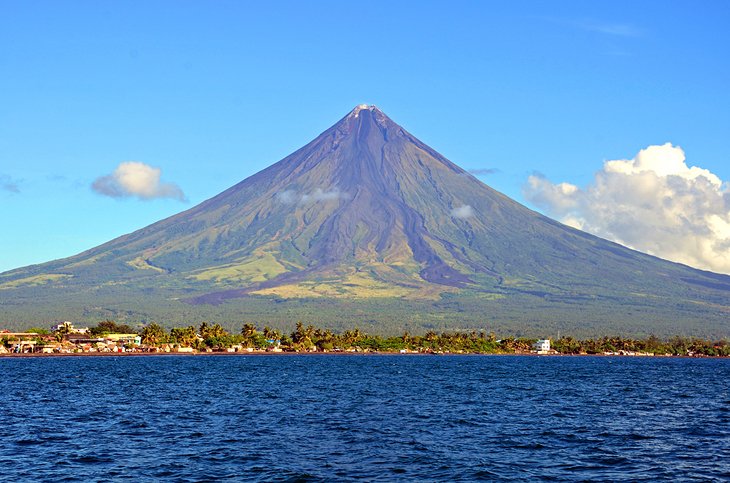
The Mayon Volcano in the Albay province on Luzon Island is a must-see in the Philippines. It is an active stratovolcano with an elevation of more than 2,400 meters. The Mayon volcano has a perfect cone peak.
Most visitors will want to enjoy the volcano by viewing it from the ground. Nature trails in the national park grounds surround the volcano, where you can also see wildlife like parakeets and other birds.
Extreme hikers can apply for a permit to climb the volcano, but it is a difficult trek through forest, and dangerous gases are emitted near the peak, so caution is advised. The ideal time to visit is March through May, outside of the rainy season. You can take an organized trip from Manila to get here.
Island Hopping
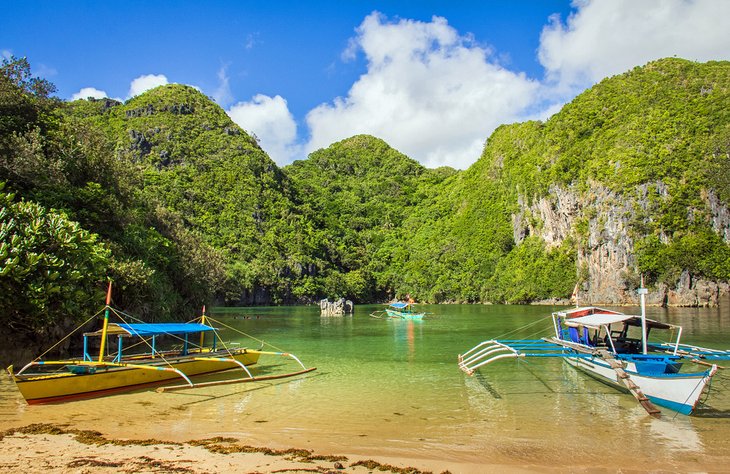
If you just cannot decide what to do or where to go in the Philippines, an island-hopping tour might offer just the right mix. You still have to whittle down choices, but an organized island-hopping tour allows you to see a collection of islands.
You can sample snorkeling, swimming, sightseeing, and dining on local food in multiple locations and eliminate the hassle of trying to plan it on your own. Many of the island hopping tours span several days. One of the most popular island-hopping tours is to the Caramoan Islands, which were made famous after being featured on the hit TV show Survivor.
Manila Historical Sightseeing Tour

Manila is an exciting and vibrant city that is a thriving metropolis surrounded by centuries-old churches and colonial history. It is easy to walk around Manila on your own, or take a guided sightseeing tour of the oldest district, the Intramuros or walled city, where you'll find some of the most significant tourist attractions and important landmarks and monuments.
This will give you a better appreciation for Manila. You can see the famous San Agustin Church and monuments at Rizal Park and Fort Santiago, each bearing a significant influence on Manila that is best shared by a guide. Some tours are offered by coach, and others are available as walking or biking tours around the city.
After your tour, stop by one of the local restaurants for lunch and enjoy modern-day Manila as you watch the colorful jeepneys flying by on the streets.
- Read More: Tourist Attractions & Things to Do in Manila
Ride in a Jeepney

Taking a ride in a jeepney is a must-experience in the Philippines, even if you have no specific destination in mind. The jeepney is one of the main forms of transportation in the Philippines. They are vehicles originally made from post-World War II U.S. army jeeps that have been transformed into colorful and fun forms of transportation.
The jeepney has become synonymous with the Philippines; a national symbol of sorts. It is unique to the country. The decorations and colorful decor on the jeepneys are as chaotic as the traffic on the city streets in places like Manila. Taking a ride in one is a thrill, with the random stops to let people on and off and being truly immersed in the local culture as residents go about their daily lives.
Try taking a jeepney to one of the tourist sites you plan to visit or to your dinner spot in the evening. It might just be the cheapest entertainment you find in the country, and it will definitely be one of the most memorable experiences.
Historic Tour of Corregidor Island

A tour of Corregidor Island is a must-see for history buffs visiting the Philippines. The island played a significant role in World War II and was the location of several battles. The relics left behind from these battles include secret tunnels and bunkers used as hideouts during the war, as well as weapons, barracks, and historical artifacts.
Be sure to take some time at the Pacific War Memorial on-site. Regular guided tours leave from Manila to a ferry that takes you to the island. This requires a full day to visit, but it is well worth the time if you have an interest in WWII history.
Bird-Watching

The stunning natural landscapes and ecosystems throughout the Philippines lend themselves to diverse habitats for birds, meaning the bird-watching opportunities are plentiful. Even if you are not an avid birder, it is worth taking a pair of binoculars on your trip to get a glimpse of some unique species that you likely will not encounter in other parts of the world.
With more than 7,000 islands and 94 national parks in the Philippines, it can be tough to narrow down where to start to look for some of the 600 species of birds that either live in or migrate through the country, like the brown-throated sunbird or the Palawan peacock-pheasant.
Some of the best places to start are the locations that cater to bird-watching like La Mesa Eco Park, which is popular among avid birders looking for barred rails, little egrets, osprey, and migratory birds that regularly rest in the park. The Negros and Panay Islands provided habitat for the endangered Walden's hornbill.
In the Luzon region, the Angat Watershed Reserve is a good spot to find many species along the trails and in the nearby Angat Rainforest and Ecological Park. Another spot where you see many migratory birds is in the Candaba Wetlands in Pampanga for species like purple herons.
Pagsanjan Falls, Laguna
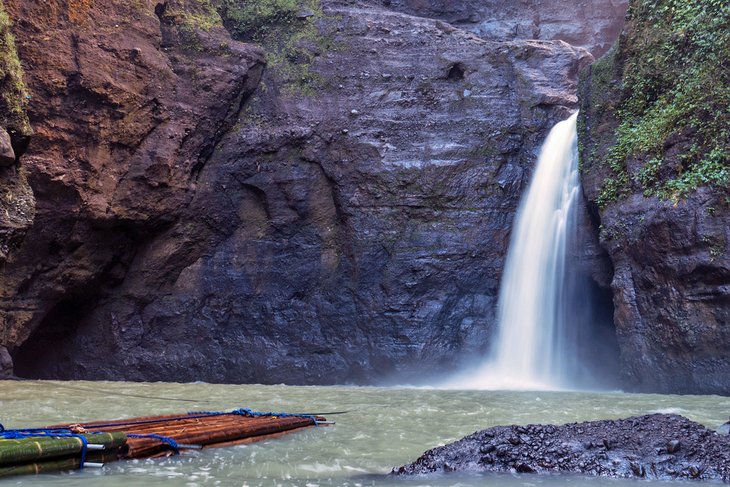
The only thing more exciting than admiring one of the most notable waterfalls in the Philippines is traversing it in a dugout canoe. The Pagsanjan Falls waterfall is part of the Pagsanjan Gorge National Park.
Your trip along the falls will take you upstream through tropical landscapes, where you will be able to swim in natural pools and pass through caves. Once you get used to the leisurely ride, prepare for the main event, as you head downstream at a fast pace through large rocks and churning water for what the locals call "shooting the rapids." It is an exhilarating outdoor adventure, and you can take day trips from Manila.
Tour Colonial Vigan

A fun place to visit with a terrific pre-colonial flair is the streets of Calle Crisologo of Vigan City, located in the Ilocos province. It stands out from other cities in the Philippines. The brick streets and traditional horse and carriage mode of transportation are reminiscent of the 16th-century trading hub that used to be for foreign traders coming through the area.
This is a fun city to spend a day or two on your trip. You can take an organized tour to learn about the city's history or stroll on your own to the small vendor shops and eateries along the main street. This is also a prime spot to find souvenirs, from bags to baskets and pottery, for a reasonable price.
Be advised that if you ask your calesa driver to take you to the best shopping area in the city, he or she might instead drop you off at a friend's shop in order to earn a kickback of your purchases. It's better to take a ride, then explore the city street shops on your own.
Taal Volcano, Talisay
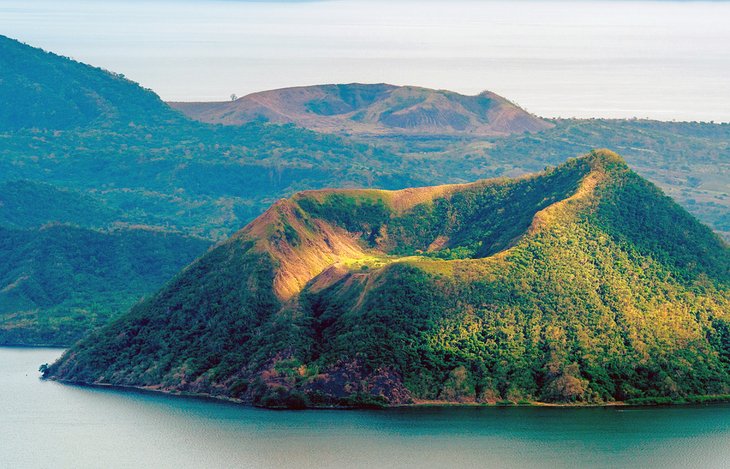
The Taal Volcano on the island of Luzon is one of the most active in the country. It is in the center of Taal Lake, so just getting to the crater is part of the adventure. The city of Talisay, where you will catch a boat to get to the crater, is less than an hour's drive from Manila. You will catch a boat to go across Taal Lake then hike to the rim of the crater.
There are a number of trails around the volcano. The Spanish Trail goes to the top of the volcano and has some of the most impressive views. The less popular Kenney Trail is a good option if you want to avoid potential crowds or if you think you might want to rest along the way.
This trail has quite a few shade trees. Due to the logistics involved in visiting Taal Volcano, you might want to consider an organized day tour.
Jungle Training, Subic Bay

When the United States Navy had an active base on Subic Bay, their Navy Seals received training by indigenous Aetas on how to survive the jungle. Now, you can visit the former base on Subic Bay and even take Jungle Environmental Survival Training from the natives.
You can take a tour of the former Subic Bay Naval Base and tour the converted complex, which has a number of activities on-site. Subic Bay is located on the island of Luzon, so it is an easy day trip from Manila, or you can stay in the region.
Hanging Bridge, Sevilla
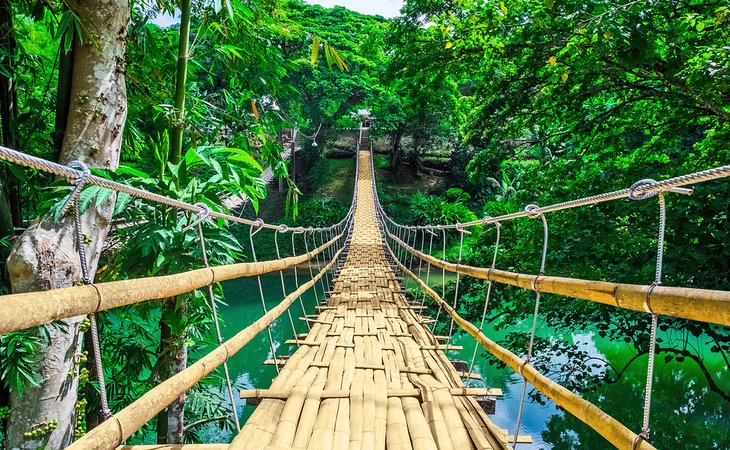
On the island of Bohol, a bridge made entirely of bamboo swings almost 40 meters in the air over the Loboc River. For those with a sense of adventure, or a desire to conquer a fear of heights, the hanging bridge walk will be a vacation experience you will never forget. The hanging bridge is in the town of Sevilla. It is easy to combine this experience with other excursions on Bohol Island.
Over the years, the bridge, which was originally made with woven bamboo, has received some safety reinforcements due to its popularity with tourists. Not to worry though, it still creeks and swings and gives you butterflies in your stomach as you look down at the rushing river below you.
Sugba Lagoon, Siargao
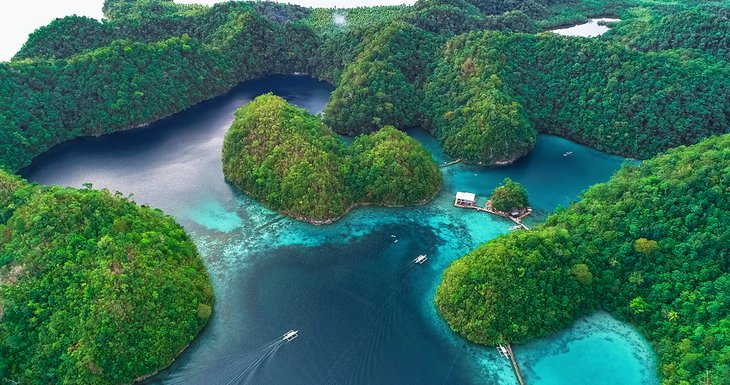
There are so many iconic lagoons in the Philippines that have movie-set quality tranquil blue waters below a towering cliffside, but one of the most spectacular is Sugba Lagoon on the island of Siargao. The lagoon is perfect for just basking in the natural, peaceful surroundings, but there are plenty of activities, too, if you want a more adventurous day.
You can book a day-trip package to the Sugba Lagoon from a nearby city like Del Carmen or General Luna, but you can also go on your own. You must take a boat to the lagoon. If you have the nerves and are not afraid of heights, you can try cliff jumping from the designated area above the lagoon. You can also rent a paddleboard or kayak, and take a more peaceful tour of the lagoon at your own pace.
Best Time to Visit The Philippines
The best time to go to the Philippines is during the dry season, which is between November and April, when you will have optimal weather conditions and the best opportunities for outdoor experiences throughout the country. This time of year has the least amount of rainfall, which means more favorable beach days, fewer chances of weather-impacted flight delays, and easier accessibility to remote regions and smaller islands.
The dry season is also the high tourist season and the most popular time to visit so you will have increased tourist activity and higher prices for airfare and lodging. During this popular time, the months of December, January and February are the coolest months to visit before the sweltering Asian heat kicks in starting in March. Keep in mind that high temperatures and humidity surge in April and May.


